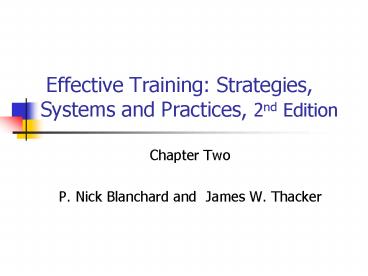Effective Training: Strategies, Systems and Practices, 2nd Edition - PowerPoint PPT Presentation
1 / 18
Title:
Effective Training: Strategies, Systems and Practices, 2nd Edition
Description:
AB. I. L. I. T. Y. High Uncertainty. Moderate Uncertainty. Low Uncertainty. Moderate Uncertainty ... show you materials, such as handouts, exercises, and videos? ... – PowerPoint PPT presentation
Number of Views:370
Avg rating:3.0/5.0
Title: Effective Training: Strategies, Systems and Practices, 2nd Edition
1
Effective Training Strategies, Systems and
Practices, 2nd Edition
- Chapter Two
- P. Nick Blanchard and James W. Thacker
2
Linkage between Strategy, Tactics, and Objectives
Tactical Activities
- Competitive
- Strategy
- Mission
- Opportunities
- Threats
- Strengths
- Weaknesses
3
Mission, Strategy, Technology, Structure
Relationship
4
Factors Influencing Environmental Stability
Low Uncertainty
Moderate Uncertainty
High Uncertainty
Moderate Uncertainty
5
Conditions Increasing the Importance of HR Issues
Part 1 of 2
6
Conditions Increasing the Importance of HR Issues
Part 2 of 2
7
Relationship between Competitive and Human
Resource Strategies
8
Components of learning Organization Part 1 of 3
9
Components of learning Organization Part 2 of 3
10
Components of learning Organization Part 3 of 3
11
Questions for the Strategic Planning Process in a
Small Business
1. Why are we in business?
2. What are we trying to achieve?
3. Who is our competition and how can we beat
them?
4. What sort of ground rules should we be
following to get the job done right?
5. How should we organize ourselves to reach our
goals and beat the competition?
6. How much detail do we need to provide so
everyone knows what to do?
7. What are the few key things that will
determine if we make it? How should we keep
track of them?
12
Environmental factors affecting the selection of
a training strategy
13
Questions to Assess Training Provider
Capabilities Part 1 of 2
What is their background (education, experience,
etc.)?
Have they ever provided these particular training
programs or services before?
Have they conducted formal evaluations of their
results? If so, what have been the results?
Can they give you the names of people in these
companies who could speak knowledgeably about
the trainers products and services?
Can they give you names of those who were
recipients of the service and those who brought
the training provider into the organization and
oversaw the training or the service?
14
Questions to Assess Training Provider
Capabilities Part 2 of 2
Can they provide an outline of their approach
and/or process? How do they go about developing a
program, delivering training, or providing a
training service?
If they are providing training they have already
developed, can they show you materials, such as
handouts, exercises, and videos?
Since these are not specific to your
organization, how will they alter them to make
them appropriate for your situation?
15
Steps in a Generic Planned Change Model Part 1
of 2
1. A compelling need for change is established.
2. Goals are developed and agreed to by the
concerned parties.
3. The cause of the need for change is
determined
4. Alternative approaches for addressing the
cause are identified and evaluated.
5. An approach to addressing the cause is
selected.
6. The approach is carried out.
16
Steps in a Generic Planned Change Model Part 2
of 2
7. The results of the approach are evaluated.
8. The results are fed back to the organization.
If results are favorable, go to step 9.
If results are unfavorable, go back to step
4.
9. The change becomes internalized. The changes
that have been made become routine and normal
ways the organization conducts its business.
17
Force-field analysis model
1. Identify the current state of the situation.
2. Envision the desired state.
3. Identify the forces restraining change.
4. Identify the forces that support or encourage
change.
5. Assess the strength of the forces.
6. Develop strategies to
reduce the forces restraining change
increase the forces for change (or capitalize on
existing drivers).
18
Differences Between OD Practicioners and Trainers
Strategic
Tactical
Middle to lower level management
Top management
Work around or within the system
Challenge and confront
Gets things done
Overly analytical































